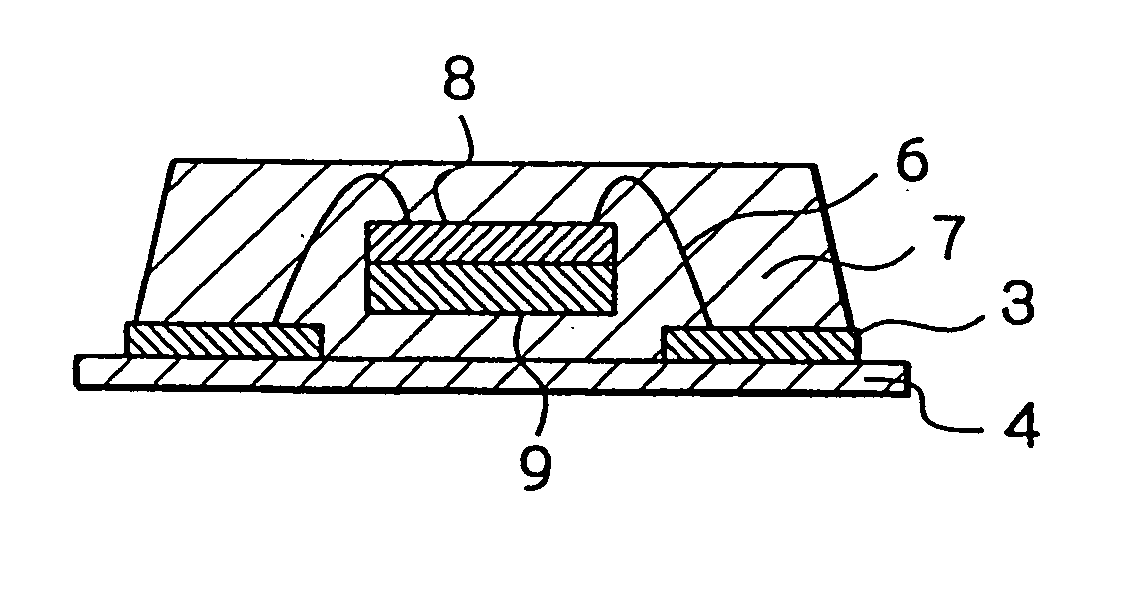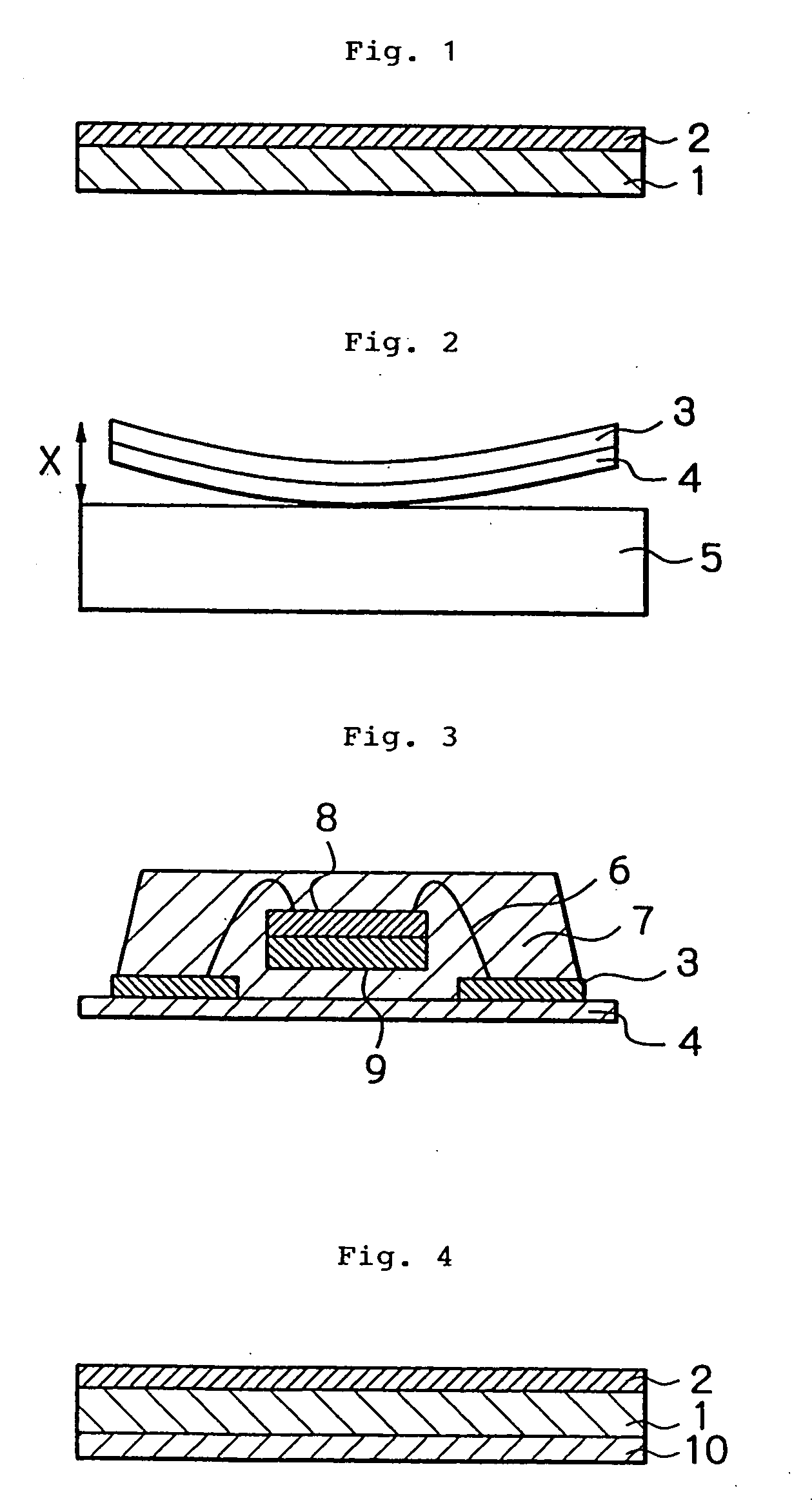Adhesive film for semiconductor, lead frame and semiconductor device using the same, and method of producing semiconductor device
a technology of adhesive film and lead frame, which is applied in the direction of film/foil adhesives without carriers, heat-activated film/foil adhesives, film/foil adhesives, etc., can solve the problems of sealing resin creeping even on the backside of lead frame, not enough area and thickness, and the sealing resin not being able to achieve the reduction in area and thickness. , to achieve the effect of easy peeling
- Summary
- Abstract
- Description
- Claims
- Application Information
AI Technical Summary
Benefits of technology
Problems solved by technology
Method used
Image
Examples
preparation example 1
Preparation of the Aromatic Polyether Amideimide Adhesive Varnish Used in Examples 1-4, 7 and 8
[0118] Into a 5-liter four neck distillation flask equipped with a thermometer, a stirrer, a nitrogen inlet tube and a fractionating column were placed 258.3 g (0.63 mol) of 2,2-bis[4-(4-aminophenoxy)phenyl]propan-e and 10.4 g (0.042 mol) of 1,3-bis(3-aminopropyl)tetramethyldisiloxane, and dissolved in 1450 g of N-methyl-2-pyrrolidone. The solution was heated to 70.degree. C., and 33.6 g (0.168 mol) of 1,12-diaminododecane was dissolved therein. The solution was cooled to 0.degree. C., and 180.4 g (0.857 mol) of trimellitic anhydride chloride was added. After the trimellitic anhydride chloride was dissolved, 130 g of triethylamine was added. After stirring for 2 hours at room temperature, the temperature was raised to 180.degree. C. and reaction was carried out for 5 hours to complete imidation. The resulting reaction solution was poured in methanol to separate a polymer. After dried, the ...
preparation example 2
Preparation of the Aromatic Polyether Amideimide Adhesive Varnish Used in Examples 5 and 6
[0119] Into a 5-liter four neck distillation flask equipped with a thermometer, a stirrer, a nitrogen inlet tube and a fractionating column were placed 258.6 g (0.63 mol) of 2,2-bis[4-(4-aminophenoxy)phenyl]propan-e and 67.0 g (0.27 mol) of 1,3-bis(3-aminopropyl)tetramethyldisiloxane, and dissolved in 1550 g of N-methyl-2-pyrrolidone. The solution was cooled to 0.degree. C., and 187.3 g (0.89 mol) of trimellitic anhydride chloride was added at the same temperature. After the trimellitic anhydride chloride was dissolved, 100 g of triethylamine was added. After stirring for 2 hours at room temperature, the temperature was raised to 180.degree. C. and reaction was carried out for 5 hours to complete imidation. The resulting reaction solution was poured in methanol to separate a polymer. After dried, the polymer was dissolved in N-methyl-2-pyrrolidone, and separated again in methanol. Drying under ...
preparation example 3
Preparation of the Aromatic Polyether Amideimide Varnish Used for Forming a Resin Layer B in Example 5
[0120] Into a 5-liter four neck distillation flask equipped with a thermometer, a stirrer, a nitrogen inlet tube and a fractionating column were placed 172.4 g (0.42 mol) of 2,2-bis[4-(4-aminophenoxy)phenyl]propan-e and 153.7 g (0.42 mol) of 4,4'-methylene-bis(2,6-diisopropylaniline), and dissolved in 1550 g of N-methyl-2-pyrrolidone. The solution was cooled to 0.degree. C., and 174.7 g (0.83 mol) of trimellitic anhydride chloride was added at the same temperature. After the trimellitic anhydride chloride was dissolved, 130 g of triethylamine was added. After stirring for 2 hours at room temperature, the temperature was raised to 180.degree. C. and reaction was carried out for 5 hours to complete imidation. The resulting reaction solution was poured in methanol to separate a polymer. After dried, the polymer was dissolved in N-methyl-2-pyrrolidone, and separated again in methanol. D...
PUM
| Property | Measurement | Unit |
|---|---|---|
| thickness | aaaaa | aaaaa |
| glass transition temperature | aaaaa | aaaaa |
| 90°-peel strength | aaaaa | aaaaa |
Abstract
Description
Claims
Application Information
 Login to View More
Login to View More - R&D
- Intellectual Property
- Life Sciences
- Materials
- Tech Scout
- Unparalleled Data Quality
- Higher Quality Content
- 60% Fewer Hallucinations
Browse by: Latest US Patents, China's latest patents, Technical Efficacy Thesaurus, Application Domain, Technology Topic, Popular Technical Reports.
© 2025 PatSnap. All rights reserved.Legal|Privacy policy|Modern Slavery Act Transparency Statement|Sitemap|About US| Contact US: help@patsnap.com



